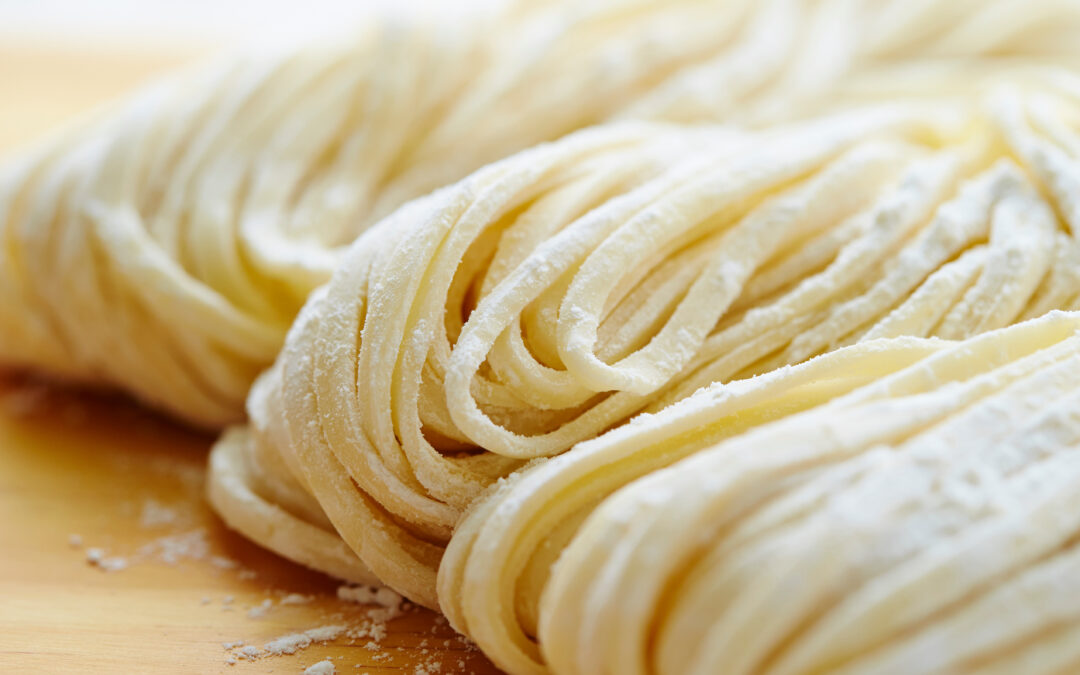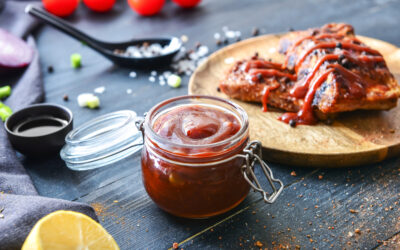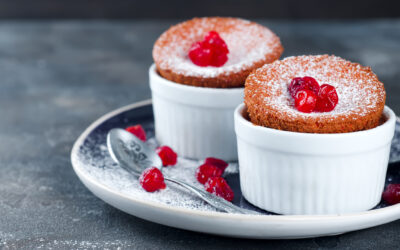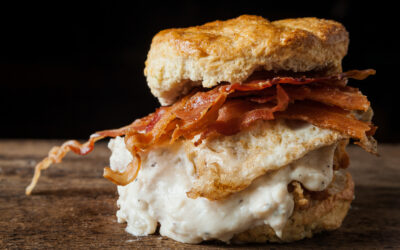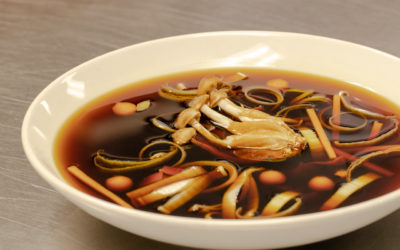Time
1 hr.
Yield
4
Ingredients
________________
- 15 Eggs
- 1 fl. oz. Olive Oil
- 1 tbsp. Salt
- 2 1/2 lb. Bread Flour
Instructions
________________
Step 1
Place the eggs, oil, and salt in a large mixer bowl. Use the paddle attachment to combine.
Step 2
Add one-third of the flour and stir until the mixture begins to form a soft dough. Remove the paddle attachment and attach the dough hook.
Step 3
Gradually add more flour until the dough is dry and cannot absorb any more flour.
Step 4
Remove the finished dough from the mixer, wrap it well with plastic wrap, and set it aside at room temperature for about 20-30 minutes.
Step 5
After the dough has rested, roll it into flat sheets by hand or with a pasta machine. Work with only a small portion at a time. Keep the remainder well covered to prevent it from drying out.
Step 6
While the sheets of dough are pliable, cut them into the desired width with a chef’s knife or pasta machine. Sheets can also be used for making ravioli.
Nutrition Information
Calories
80
Total Fat
2g
Saturated Fat
0.5g
Cholesterol
50mg
Carbohydrates
13g
Protein
3g
MAKING PASTA by hand
Step 1
Mound the flour on a workbench or a flat surface. Make a hole in the center. Place the eggs in the hole and whip them with a fork.
Step 2
Use your fingers to stir the eggs, gradually bringing more flour into the center.
Step 3
Use a dough scraper, to add more flour to the egg mixture, stirring constantly until a firm dough is formed.
Step 4
Knead the dough until smooth.
Alumni Story: Caitlyn Halcomb
Discover how to be affective leader in the kitchen. Learn the chef’s essential leadership qualities and implement them for success.
How to Be an Effective Leader in the Kitchen
Discover how to be affective leader in the kitchen. Learn the chef’s essential leadership qualities and implement them for success.
Books All Chefs Should Read, According to Professional Chefs
Contrary to what some people may believe, becoming a chef – least of all an excellent one – isn't...
The Highest Paying Culinary Jobs and Positions
The culinary world can be an exciting industry that many hope to join in the future. If you’re...
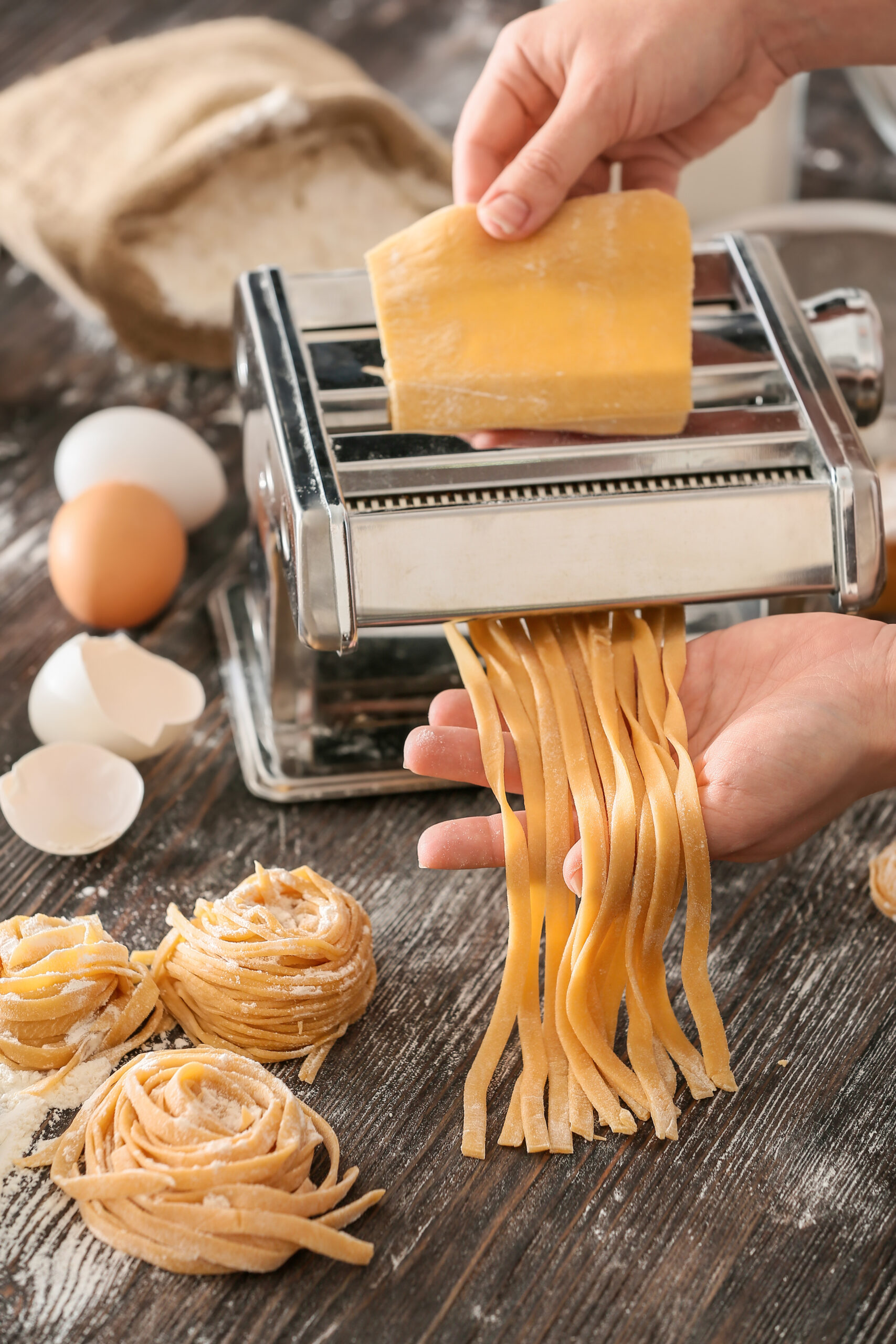
Pasta Nutrition
Pasta is a healthy choice in a balanced diet because they are very low in sodium and fat. Pasta can be made from different types of flours. When making pasta with wheat flour it provides a good source of vitamin B, minerals, proteins, and carbohydrates. Some pastas are substituting flour for rice, potato, bean, or lentil to become gluten-free. These pastas can provide additional nutritional benefits and are a good alternative for those with a wheat protein allergy.
Cooking Pasta
Cooking times vary depending on the shape and quantity of pasta, the amount of water used, the hardness of the water, and altitude. Contrary to boxed pasta, fresh pasta cooks within a matter of seconds. Boiling is the most common method to cooking pasta. A secret is to boiling a perfect pasta is to use ample water. Allow 1 gallon of water for each pound of pasta. Using a large saucepan or stockpot to allow the pasta to move freely will help avoid the pasta from becoming gummy and sticky when the starches are released. Bring the water to a boil, add salt, then add all the pasta at once. Salt is added to the water before adding the pasta because the pasta absorbs the water and salt during cooking providing a seasoning effect.
MAKING PASTA WITH A PASTA MACHINE
Step 1
Work with a small portion of the dough. Leave the rest covered with plastic wrap to prevent it from drying out.
Step 2
Flatten the dough with the heel of your hand.
Step 3
Set the pasta machine rollers to their widest-setting. Insert the dough and turn the handle with one hand while supporting the dough with the other hand. Pass the entire piece of dough through the rollers.
Step 4
Dust the dough with flour, fold it in thirds and pass it through the pasta machine again.
Step 5
Repeat the folding and rolling procedure until the dough is smooth. This may require four to six passes.
Step 6
Tighten the rollers one or two marks. Pass the dough through the machine. Without folding it in thirds, pass the dough through the machine repeatedly, tightening the rollers one or two marks each time.
Step 7
When the dough is thin enough to see your hand through it, but not so thing that it begins to tear, it is ready to use or cut into ribbons. This sheet is the sfoglia.
Step 8
To cut the sfoglia into ribbons, gently feed a manageable length of dough through the desired cutting blades.
Step 9
Lay out the pasta in a single layer on a sheet pan dusted with flour to dry. Layers of pasta ribbons can be separated with parchment paper.
More Recipes
HOW TO: Mother Sauces
CSFTW Chef Instructor Mark Hitri demonstrates the proper technique for making the five French mother sauces.
Maki Sushi Recipe
Learn how to hand-roll and prepare a sushi roll.
Raspberry Soufflé with Raspberry Coulis
Homemade delicious and easy raspberry souffle with a raspberry coulis.
Country Biscuits
Light and fluffy, melt-in-your-mouth herbed country biscuits are seasoned with savory herbs.
Seafood Extravaganza Bloody Mary
Looking for a spicy meal? Try this seafood extravaganza. It is both a drink and a meal!
Beef Consommé
What is a Consommé? A consommé is a stock or broth that has been clarified to remove impurities so...
